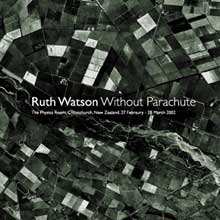 |
|||||||||
|
|
| ...GALLERY EXHIBITS 2002 | ...WHAT COLOUR IS YOUR PARACHUTE? | |||||||||
|
Andrew Paul Wood The title of this exhibition is Without Parachute. This essay was written ‘without parachute’, only having an outline of what the work would look like, based on frantic trans-Tasman faxes, emails and ‘phone calls. Art is sort of our parachute, but what is art’s parachute, or the writer’s? The trick is to not let the gravity splat you. In the middle of the white, boundary-absorbing gallery space, backed by a panoramic view of Christchurch’s Port Hills, will stand a dress from 1860s, supported by a dressmaker’s dummy. It looks like a forlorn, headless Victorian ghost. The dress, made up from stitched together sections of fabric printed with more contemporary aerial photographs of New Zealand, references the era in which Watson’s twice great grandmother emigrated to New Zealand from Ireland, moving to a country she had never seen. The long distance view of the land, worn close to the skin, intimates a profound dislocation of place and space. Martha Leatham also arrived in New Zealand- presumably without parachute - never to see Ireland again. We can barely imagine now such irreversibility in relation to place now, in our supposedly globalised, interconnected world. The design of the dress is simple and clean, contrasting with Yinka Shonibare’s ornate Edwardian evening dress, made from kenti cloth in the mid-1990’s. This very plain- and plane-ness is Watson’s way of registering class, work, the everyday and the domestic. It is also interesting to note that the science (or art?) of cartography has traditionally been a male domain. And if this is a convention, Watson is interested in nothing so much as deliberately tampering with it. Games and play have been a long-standing tactic of Watson’s practice. This aerial dress is therefore of silk, a symbolic and a subversive fabric. Empires were built on the stuff, and the silkworm’s work was one of the most closely guarded industrial secrets of the ancient world. Silk is also a product of death: the silkworm is killed by immersion in boiling water before the silk can be unwoven from its cocoon. Silk seems overly connected to feminine worlds and yet intimately bound up with masculine preoccupations too, especially that of war. Nylon stockings became popular during the Second World War because silk was rationed for parachutes, and soldiers in the trenches are rumored to have acquired women’s silk underwear because it wouldn’t harbor lice. The Airforce World museum at Wigram has in its collection dresses made from parachute silk, and maps of the Pacific hand drawn on silk (or rayon). Silk and fabric maps were strong, could survive getting wet and being crumpled, and were carried by pilots so that if they crashed, they could follow the ocean currents - like Pacific Islanders and pre-classical Maori - and wouldn’t land their dinghies on Japanese occupied islands. On one wall of the gallery are some "jewels" the artist has made, also inspired by items in the collection at Airforce World. Watson’s jewels are made from resin, and have embedded within them shaped photographic details of landscapes. These are based on the pendants and broaches made from the Perspex windscreens of crashed planes by New Zealand POWs in the Pacific during World War II. This work is particularly relevant in a post-colonial world where identity is eroded and uncertain - clearly evident in New Zealand’s concern for national identity and cautious negotiations within a multicultural existence. In the era of GPS and landsat where everyone can now know exactly where they are geographically, without knowing who they are, or where they come from, these works return something of a human and spiritual dimension to our cartographic imaginings. From the Catalogue Without Parachute
|
|||||||||
